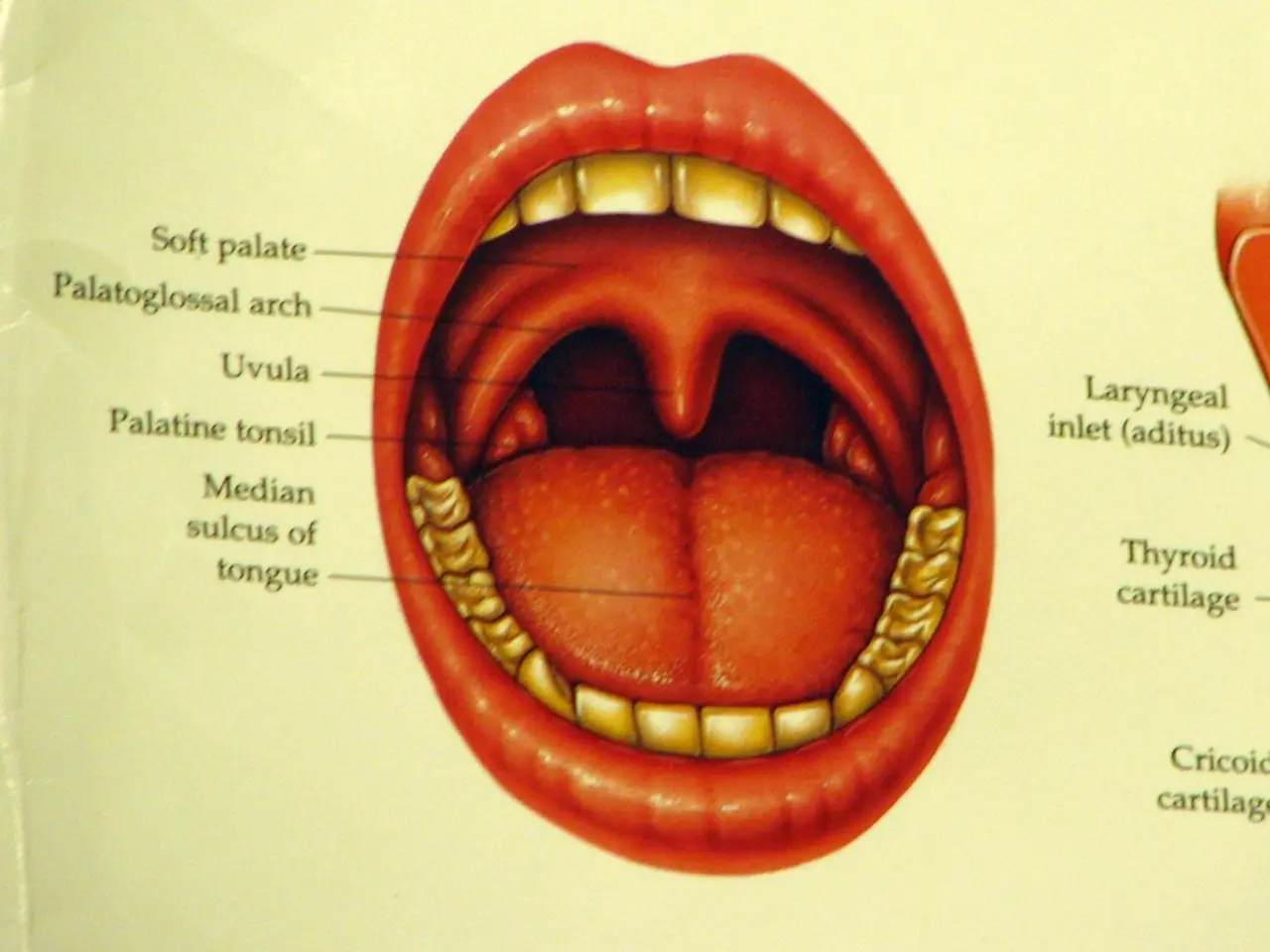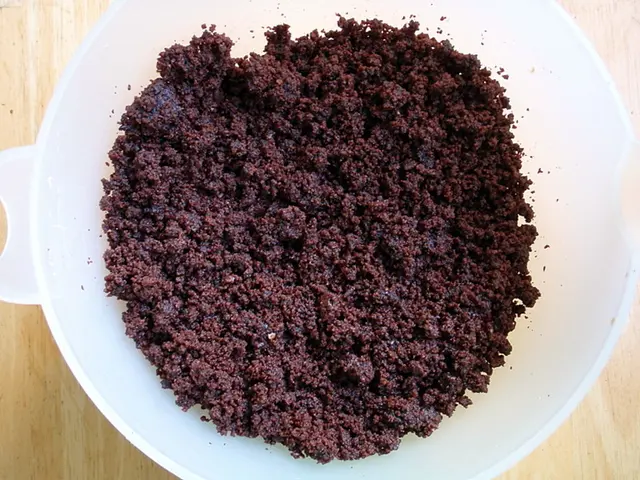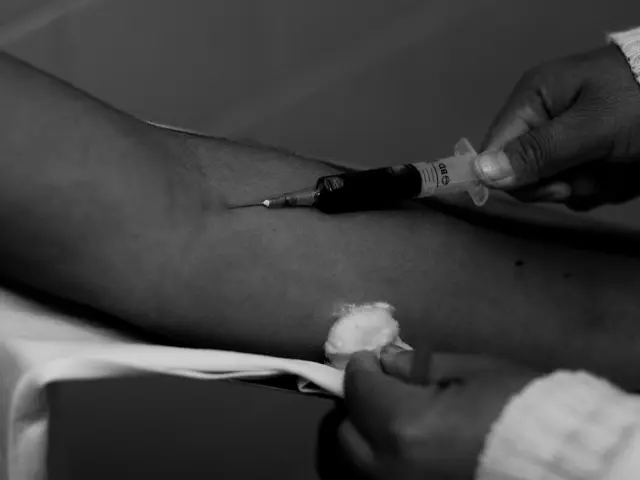Tongue discoloration in green: Causes, infections, and possible remedies
In the realm of oral health, a green tongue might raise some concerns. While it's less common than other discolorations, it can be a sign of various conditions. This article explores the typical causes, symptoms, and treatment options for a green tongue.
A green tongue is often linked to bacterial or fungal overgrowth, poor oral hygiene, or debris accumulation. Bacteria or fungi can produce pigments or accumulate debris, leading to unusual colors, including green. Poor oral hygiene, food debris, and dead cells can all contribute to this discoloration.
Oral thrush, a fungal infection caused by Candida, is a common culprit. Symptoms include a greenish discoloration, possible white patches, soreness, bad breath, or a burning sensation. Improved oral hygiene, antifungal medication, professional dental cleaning, and sometimes antibiotics can help treat oral thrush.
Hairy tongue, characterised by overgrowth and elongation of the filiform papillae on the tongue, can also lead to greenish discoloration. This condition is caused by the trapping of bacteria and food particles that may be pigmented. Improved oral hygiene, tongue scraping, quitting smoking, and avoiding food or drinks that stain the tongue can help manage hairy tongue.
Certain foods or medications can also cause temporary green staining. Avoiding these offending items and maintaining good oral hygiene usually resolves the discoloration.
While serious causes like geographic tongue or oral cancer are less likely to cause green discoloration, they may present with other color changes and symptoms requiring medical evaluation. If the green discoloration persists despite good oral hygiene, is accompanied by pain, swelling, difficulty swallowing, or systemic symptoms like fever, or if over-the-counter remedies fail to resolve the issue, it's important to seek medical advice.
In some cases, antibiotics may be prescribed for bacterial infections causing a green tongue. Antifungal medications may be necessary for fungal infections. A biopsy may be required if a doctor suspects oral cancer.
It's essential to maintain proper oral hygiene to support treatment efforts for a green tongue. Tongue scraping should be done after consulting a doctor or dentist. Regular brushing of the tongue, improved dental hygiene routines, and rinsing with antimicrobial mouthwash can help manage the issue.
In conclusion, a green tongue most commonly results from bacterial or fungal overgrowth and poor oral hygiene. Treatment focuses on proper oral care, antifungal or antibiotic therapies if needed, and avoiding staining agents. If you're experiencing a persistent green tongue, it's always best to consult a healthcare professional for a proper diagnosis and treatment plan.
- A green tongue might signal various medical conditions, though it's less common than other discolorations.
- Bacteria or fungi can produce pigments or accumulate debris, causing a green tongue.
- Poor oral hygiene, food debris, and dead cells can contribute to a greenish discoloration.
- Oral thrush, a fungal infection, can result in a greenish tongue with possible white patches, soreness, bad breath, or a burning sensation.
- Improved oral hygiene, antifungal medication, professional dental cleaning, and sometimes antibiotics can help treat oral thrush.
- Hairy tongue, characterized by overgrowth and elongation of filiform papillae, can lead to greenish discoloration.
- This condition is caused by the trapping of bacteria and food particles that may be pigmented.
- Improved oral hygiene, tongue scraping, quitting smoking, and avoiding staining foods can help manage hairy tongue.
- Certain foods or medications can cause temporary green staining.
- Avoiding these offending items and maintaining good oral hygiene usually resolves the discoloration.
- While serious causes like geographic tongue or oral cancer are less likely to cause green discoloration, they may present with other color changes and symptoms.
- It's important to seek medical advice if the green discoloration persists, is accompanied by pain, swelling, difficulty swallowing, or systemic symptoms like fever.
- In some cases, antibiotics may be prescribed for bacterial infections causing a green tongue.
- Antifungal medications may be necessary for fungal infections.
- A biopsy may be required if a doctor suspects oral cancer.
- Maintaining proper oral hygiene is essential to support treatment efforts for a green tongue.
- Tongue scraping should be done after consulting a doctor or dentist.
- Regular brushing of the tongue, improved dental hygiene routines, and rinsing with antimicrobial mouthwash can help manage the issue.
- Science plays a crucial role in understanding and treating different medical conditions, including a green tongue.
- A green tongue is a type of digestive health concern, as it can be linked to bacteria and fungal overgrowth.
- Eye-health, hearing, and skin-care are other important aspects of health and wellness that should not be overlooked.
- Fitness and exercise contribute to cardiovascular health, which is vital for overall well-being.
- Autoimmune disorders, such as ulcerative colitis, psoriatic arthritis, and spondylitis, affect various parts of the body and require specific treatments.
- Science continues to explore the relationship between diet, nutrition, and chronic diseases, like cancer and diabetes.
- Respiratory conditions like asthma and COPD can be managed with medications, therapies, and lifestyle changes.
- Mental health conditions, such as depression and anxiety, can impact one's quality of life and benefit from various therapies and treatments.
- Skin conditions, like eczema, psoriasis, and acne, can be treated using topical creams, oral medications, and light therapy.
- Neurological disorders like HIV, multiple sclerosis, and Alzheimer's disease require specialized medical care and management through therapies and treatments.








